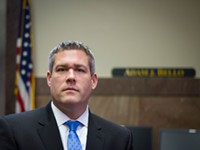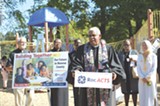[
{
"name": "500x250 Ad",
"insertPoint": "5",
"component": "15667920",
"parentWrapperClass": "",
"requiredCountToDisplay": "1"
}
]
County Executive Cheryl Dinolfo makes some very important investments in her 2018 budget proposal. The plan includes roughly $3 million to add 30 Child Protective Services caseworkers, restores $1.7 million for services that have been proven to reduce child abuse and neglect, and boosts child day-care funding by $1.6 million.
These are the very investments that community members, children's advocates, and County Legislature Democrats have been asking for, in some cases for several years.
They've sought increased day-care funding so that more struggling parents can work and become self-sufficient. They've asked for preventive services funding because not only do the programs help overwhelmed parents, but the children in those families also tend to do better in school down the road. And Child Protective Services caseloads have been a concern for some time; more caseworkers mean more people to take on difficult, complex work.
The groups say they have been pleased to see the additional resources. Members of the Children's Agenda, a local advocacy group that analyzes the county budget every year, were thrilled when Dinolfo announced the additional CPS staff in October, for example. And they were also pleased when they learned that her budget added funding for preventive services; the organization and some faith leaders had been preparing to press the county on the issue.
But the advocates and Democrats tempered their praise for the investments with a dose of wariness. The funding had to come from somewhere, and their worry has been that the Dinolfo administration pulled the money from other social services. And the Department of Human Services budget does show some substantial funding decreases alongside the increases: public assistance benefits drop by $3 million, for example.
Democrats aren't raising alarms yet, but even after last week's budget hearings they still have questions about some of the funding shuffles in Human Services, says Democratic Minority Leader Cynthia Kaleh. They also have broader concerns about staffing or salary increases in a couple of county departments; about the inclusion of casino revenue in the budget, and about some of the assumptions the budget makes about public assistance caseloads.
"It's just not a clear picture," says Kaleh.
Bob Franklin, the county's chief financial officer, says the reduction in funds for temporary assistance benefits is "math driven." The county looks at the number of active cases it has and the average cost of those cases, then comes up with a projection for use in the budget, he says.
DHS employees have focused on helping people find work instead of relying on public assistance, Franklin says. And with the local economy improving, more people have been able to transition to employment, he says. (Critics say the job-search requirements – imposed by federal and state governments, as well as the county – can be onerous.)
"Rather than say, 'Hey DHS, great job saving money; we're going to take that for something else,' we kept that in the DHS budget," Franklin says. So they've basically had the ability to take any savings and invest them in other areas if Human Services, he says.
The county is projecting slightly fewer public assistance cases next year. If caseloads do exceed what the county budgets, officials will have to find additional funding somewhere else in the Human Services department or from some other area of county operations, Franklin says.
Brigit Hurley, a policy analyst for the Children's Agenda, says her organization is happy with the increases for Child Protective Services, preventive services, and child day-care subsidies. But she says she was surprised that the budget doesn't include more on Raise the Age, a statewide change in the way 16- and 17-year-olds are prosecuted for non-violent crimes.
The program could affect the county in a few ways, from how the youths are prosecuted to how they're detained or transported by sheriff's offices, according to the state's Raise the Age website.
The county's probation department, which supervises juvenile offenders, did add funding for two additional officers in preparation for the change, Franklin says. The department is getting state funding to offset those additions, since state officials vowed to cover counties' incremental costs associated with Raise the Age, he says.
The county Department of Human Services provides some services to juvenile offenders. What sort of adjustments the department may have to make for Raise the Age aren't clear, since the state hasn't provided counties with specific guidance or regulations.
Earlier this year, the county learned that it wouldn't be getting $4 million in payments it was expecting through a casino revenue-sharing agreement between New York State and the Seneca Nation. The Senecas argue that the agreement has expired – state officials disagree – and that it no longer needs to give the state a cut of its gambling revenue.
This year, the county was able to plug the $4 million hole left by the casino revenue loss through a stroke of luck. County sales tax revenues for 2017 are on track to top projections by $5 million, Franklin says. So for 2017, the sales tax surplus basically offsets the casino revenue shortfall.
Dinolfo's 2018 budget does include $3.2 million in revenue from the Seneca-New York casino revenue sharing agreement, Franklin says. But county officials know that the money is iffy. So they came up with a plan: they devoted the money to paying their pension costs.
If the county gets Seneca casino revenue in 2018 – or has some other sort of windfall, such as higher-than-expected sales tax collections – it'll use the money toward its pension obligations. If the money doesn't come through, the county will defer $3.2 million worth of pension costs, which it can then pay back gradually over 10 years, Franklin says.
The county has deferred pension payments through that mechanism, which the state allows, for the past few years. Officials are trying not to do that this year, Franklin says.
Legislators will dig deeper into the budget during the County Legislature's Ways and Means Committee meeting at 5:30 p.m. Thursday, December 7. Democrats in particular tend to use that meeting to deeply scrutinize the finer points of the exec's budget proposal.
The meeting, which doubles as a public hearing on the budget, happens in the legislature's chambers in the County Office Building, 39 West Main Street.
The full legislature will most likely vote on the budget during its December 12 meeting.
Speaking of...
-

Monroe County faces staggering budget shortfall
Apr 30, 2020 -

County lowers fees for subsidized child care
Jul 9, 2019 -

Youth ask county for climate plan
May 22, 2019 - More »
Latest in News
More by Jeremy Moule
-

ROCHESTER TEN
ANNETTE RAMOSAug 1, 2023 - More »






